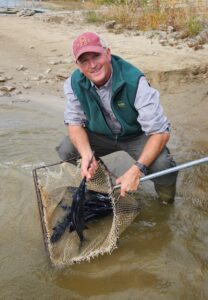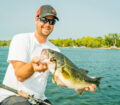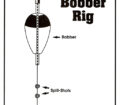By Steve Weisman

(photo by Iowa DNR) Chris Clouse, Hatchery Biologist at the Rathbun State Fish Hatchery, shares the size of the paddlefish that will be re-introduced
As I attended the presentation by Mike Hawkins, Iowa DNR fisheries biologist, on Saturday, August 10, I expected to hear an update about the lake bank erosion and restoration. What I didn’t expect was Hawkins’ announcement toward the end of his presentation. He began by saying, “I wanted to make this announcement. We’ve talked with a few groups in the area, about the reintroduction of paddlefish to the Iowa Great Lakes. As a fisheries biologist, we don’t get to do this type of thing very often, especially a native species. To bring back a native species back into the lake is a pretty big deal. It’s a unique opportunity. We’ve been talking about this inside the fisheries bureau for quite a long time.”
According to Hawkins, the thought is that this fish has been gone from the lakes since about 1919, and as far as they can tell, they were native to the Iowa Great Lakes. Historically, there are lots of photographs floating around of paddlefish being caught in the early 1900s through about 1916. Hawkins says, “They probably disappeared because of fragmentation of the river systems with the dams that were put in place. Those dams would stop the upstream migration. These fish don’t reproduce in lake systems and are a river fish.” Before the dams, the paddlefish would make the long migration to the Iowa Great Lakes.
The American paddlefish is actually the only species of paddlefish left in the world.
Restoration efforts have been very successful across the Midwest and here in the Missouri and Mississippi river systems in Iowa. There is actually a limited season on paddlefish on the Missouri River side and the Big Sioux River in the state.
The DNR has been looking at other areas in the state to stock the paddlefish. Hawkins says, “The Iowa Great Lakes because of its history of having paddlefish was a natural choice to do some stocking here.” They are a big fish with stories and pictures from the early 1900s of fish of 185 pounds and even one (not documented) of 210 pounds, both caught on West Okoboji.
They are a truly prehistoric fish millions of years old.
Here is some more information taken from the Iowa DNR’s website on fish species. The are filter feeders: zooplankton, insect larvae. The food organisms are filtered from the water by the gill rakers as the fish swims about with its mouth open.
Paddlefish are best known for their long paddle-like snout. It has been suggested that it is used to stir up the bottom to help with feeding, serves as a “rudder” to guide the fish and/or is a sense organ to find food organisms. Since the paddlefish is not a bottom feeder and the snout has an elaborate system of sense organs, the latter theory seems logical as the primary function of the appendage.
The DNR site offers information about size. Fish over 6-feet long have been taken from Iowa, placing it at or near the top of the list for “big fish” honors. Early growth of paddlefish is fast with fish reaching 10- to 14- and 21- to 24-inches in their second and third years of life. Seventeen-year-old fish average nearly 60-inches long and weigh about 37-pounds. Paddlefish are long-lived fish with 20 years common and 30 years or more not unusual. The larger fish are females.
Hawkins talked about stocking. “In the next few weeks, as soon as the water cools, we will be bringing in fish that have been raised down at the Rathbun hatchery in southern Iowa. Fish are from a wild population and have great wild genetics. We are going to be stocking about 1,900 of them into West Okoboji. We’d like to put tags in some of these fish so we can track them through time. We hope they provide a small population and some recreational opportunities.”
















